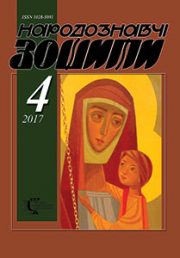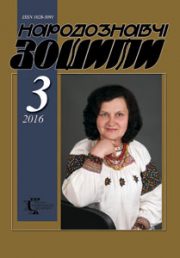The Ethnology Notebooks. 2022. № 4 (166), 876—884
UDK [392.51:[664.661.21:641.526.2]](477.46)
DOI https://doi.org/10.15407/nz2022.04.876
YOVENKO Larysa
- ORCID ID: https://orcid.org/0000-0003-1035-071X
- Doctor of Pedagogical Sciences, Associate Professor of Ukrainian
- Literature, Ukrainian Studies and Teaching Methods Department,
- Uman state pedagogical university of the name of Pavlo Tychyna,
- 2, Sadova str., 20300, Uman, Tcherkasy area, Ukraine,
- Contacts: e-mail: art_dekanat@meta.ua
TERESHKO Іnna
- ОRCID ID: https://orcid.org/000-0002-5682-7766
- Candidate of Pedagogical Sciences, Associate Professor
- of Choreography And Artistic Culture Department,
- Pavlo Tychyna Uman State Pedagogical University,
- 2, Sadova str., 20300, Uman, Tcherkasy area, Ukraine,
- Contacts: e-mail: art_dekanat@meta.ua
Abstract. The purpose of the article: the study of the ritual and mythological essence of the rite of «baking a loaf», the presentation of the features of its life in the historical Uman region during the XXth early XXIst centuries. The research methodology consists in the application of cultural (to understand the evolution and transformation of the rite of «baking a loaf», to identify the deep foundations, the most significant trends of its development), chronological-historical (to express the peculiarities of the researched rite at various stages of the development of Ukrainian traditional household culture), expeditionary methods (for the study of local-territorial features of the rite on the territory of the historical Uman region), as well as the method of theoretical generalization.
The scientific novelty of the article lies in the expansion of ideas about the rite of «baking a loaf», the study of its local-territorial features in the historical Uman region in the available scientific sources and materials of folklore-ethnographic expeditions of students and teachers of the Faculty of Ukrainian Philology of the Ukrainian Studies and Teaching Methods Department (1997—2018). Conclusions. Thus, the studied rite has a deep archaic meaning. It has been established that this rite reflects: 1) a connection with magic (ritual sacrifice); 2) cult of the sun; 3) connection with nature, animal and plant life, fertility of the earth; 4) cult of fire and earth. The study of scientific works, archival materials of the research laboratory «Problems of training future philology teachers for Ukrainian studies work at school» (Uman State Pedagogical University named after Pavel Tychyna) showed that the ritual of baking bread in the villages of the historical Uman region retains authentic features and has a peculiar ritual script, which is manifested in the recorded local and territorial features of its implementation. This ceremony is still an important part of the wedding ceremony of the Uman region. A thorough study of regional forms of folklore in the educational process of higher education institutions has significant potential in popularizing the cultural heritage of the native ethnic group, fostering respect for the material and spiritual heritage of Ukrainian and other peoples.
Keywords: rite, korovai, wedding, korovainytsi, songs, historical Uman region.
Received 2.08.2022
REFERENCES
- (1999, june 19). Joint declaration of the ministers of education of Europe «European space in the field of higher education». Bologna. Retrieved from: https://zakon.rada.gov.ua (access date: September 26, 2020) [in Ukrainian].
- (1984). UNESCO. Declaration of Mexico City Policy on the Sphere of Culture. Culture, 3 [in Ukrainian].
- (2016). New Ukrainian school. Conceptual principles of secondary school reform. Retrieved from: http://mon.gov.ua/activity/education/zagalna-serednya/ua-sch-2016/ (access date: October 8, 2020) [in Ukrainian].
- On higher education: Law of Ukraine dated July 1, 2014 № 1556-VII. Date of update: 09/28/2017. Retrieved from: http://zakon2.rada.gov.ua/laws/show/1556-18 (date of application: September 21, 2020) [in Ukrainian].
- Vovk, H.K. (1995). Studies in Ukrainian ethnography and anthropology. Kyiv: Art [in Ukrainian].
- Sumtsov, N.F. (1996). Symbolism of Slavic rites: Selected works. Moscow: Eastern literature [in Ukrainian].
- Afanasyev, A.N. (2002). Myths, beliefs and superstitions of the Slavs (Vol. 1). Moscow: Eksmo; St. Petersburg: Terra Fantastica [in Russian].
- Sivachuk, N.P. (2010). Uman wedding. Uman: Almi [in Ukrainian].
- Semenchuk, V. (2014). Folklore of the village of Rohy, Uman district, Cherkasy region. Uman: PP Yellow [in Ukrainian].
- Osipenko, N.S., & Honcharuk, V.A. (2019). Folklore heritage of Pugachivka village, Uman district, Cherkasy region. Uman: ALMI [in Ukrainian].
- Tereshko, I., & Yovenko, L. (2012). Folklore and ethnographic heritage of Tymoshivka village, Mankiv district, Cherkasy region. Uman: PP Yellow [in Ukrainian].
- Zhayvoronok, V.V. (2006). Signs of Ukrainian ethnoculture: Dictionary-reference. Kyiv: Trust [in Ukrainian].
- Nalyvaiko, S. (2000). Sanskrit reveals secrets. Kyiv: Prosvita [in Ukrainian].
- (1997). Poetics of plot and genre. Moscow: Labyrinth [in Russian].
- Yovenko, L., & Tereshko, I. (2013). Folklore and ethnographic heritage of the village of Cherpovody, Uman district, Cherkasy region. Uman: PP Yellow [in Ukrainian].
- Meletynskyi, E.M. (Ed.). (1990). Mythological dictionary. Moscow: Soviet Encyclopedia [in Russian].
- Research laboratory «Preparation of future philology teachers for Ukrainian studies work at school». 12.06.2001. Archive. F. 177. Recorded from Maria Korniivna Shevchenko, born in 1921, a resident of the village of Korzhova, Uman district, Cherkasy region [in Ukrainian].
- Research laboratory «Preparation of future philology teachers for Ukrainian studies work at school». 1.06.2009. Archive. F. 197. Recorded from Solokha Anna Kindrativna, born 1946, Kryzhanivska Nina Hryhorivna, born 1948, Lykera Alemivna Tkachenko, born 1930, a resident of the village of Tanske, Uman district, Cherkasy region [in Ukrainian].
- Research laboratory «Preparation of future philology teachers for Ukrainian studies work at school». 10.06.1999. Archive. F. 97. Recorded from Tekla Tykhinivna Tkachenko, born in 1930, a resident of the village of Oksanyne [in Ukrainian].
- Research laboratory «Preparation of future philology teachers for Ukrainian studies work at school». 9.06.2008. Archive. F. 298. Recorded by Hanna Stepanivna Slyusar, born in 1935, a resident of the village of Gromy [in Ukrainian].
- Voytovych, V.M. (2002). Ukrainian mythology. Kyiv: Lybid [in Ukrainian].
- Research laboratory «Preparation of future philology teachers for Ukrainian studies work at school». 06.4.2000. Archive. F. 436. Recorded from Kryzhanivska Marusa, 1928, born and Drobot Parasky, born in 1927, a resident of the village of Legedzyne, Talniv district, Cherkasy region [in Ukrainian].






